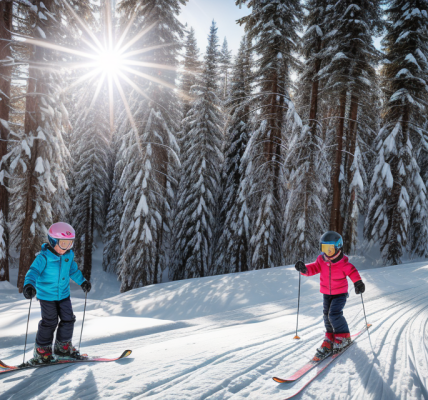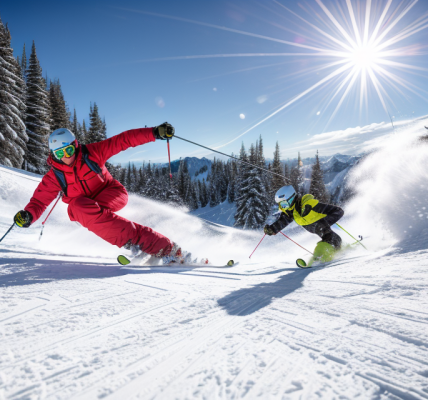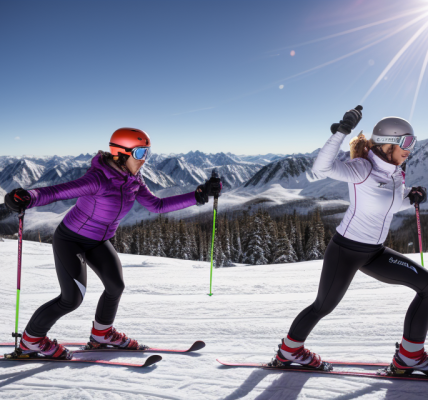Mastering Your Skiing Form: A Comprehensive Guide to Improving Your Skills
Are you looking to take your skiing to the next level? Want to improve your form and become a more confident and skilled skier? Look no further! In this comprehensive guide, we will cover everything you need to know to master your skiing form and take your skills to new heights. From understanding the basics of good skiing form to advanced techniques for improving your performance, we’ve got you covered. So whether you’re a beginner or an experienced skier, read on to discover how you can improve your skiing form and become the best skier you can be!
Understanding the Basics of Skiing Form
Body Position and Balance
Maintaining the correct body position and balance is crucial to achieving optimal skiing form. The following are some key points to consider:
Importance of a Neutral Body Position
A neutral body position is essential for effective skiing. This means that your body should be aligned in a way that allows you to control your movements and maintain balance. A neutral body position involves the following:
- Feet hip-width apart
- Knees slightly bent
- Weight evenly distributed on both skis
- Shoulders relaxed and facing downhill
- Head up and looking forward
Aligning Your Body with the Fall Line
The fall line is the path that a skier naturally follows as they move down a slope. It is important to align your body with the fall line to ensure that you are using gravity to your advantage and maximizing your control over your movements. To align your body with the fall line, visualize an imaginary string connecting your head to your tailbone, and make sure that your body is facing downhill along this line.
Maintaining Balance through Shifting Weight
Shifting your weight is a critical aspect of maintaining balance while skiing. By moving your weight from one ski to the other, you can adjust your balance and control your movements. To shift your weight, simply bend your knees and shift your body weight in the direction you want to turn. It’s important to maintain a balanced distribution of weight between your skis at all times, and to avoid leaning too far to one side or the other.
By mastering your skiing form and paying close attention to your body position and balance, you can improve your skills and enjoy a more confident and enjoyable skiing experience.
Edge Control and Turning
When it comes to skiing, edge control is a crucial aspect of mastering your skills. Edge control refers to the ability to use the edges of your skis to control your movements and direction on the slopes. Learning how to use edge control effectively can greatly improve your skiing form and help you become a more confident and proficient skier.
One of the key elements of edge control is learning how to make efficient turns. There are several different types of turns that you can make on the slopes, including round turns, square turns, and long turns. Each type of turn requires a slightly different approach and technique, so it’s important to learn them all in order to become a well-rounded skier.
One of the most important things to understand when making turns is the concept of pressure and release. This means that you need to apply pressure to the edges of your skis in order to initiate a turn, and then release that pressure as you come out of the turn. If you don’t apply the right amount of pressure or don’t release it at the right time, you may find yourself struggling to make smooth, efficient turns.
To master edge control and turning, it’s important to practice regularly and seek out feedback from experienced skiers. You can also try taking a skiing lesson or joining a skiing clinic to get personalized instruction and guidance from professionals. With time and practice, you’ll be able to develop your edge control skills and become a more confident and proficient skier.
Developing Strong Fundamentals
Ski Fitness and Strength Training
Skiing is a physically demanding sport that requires strength, endurance, and agility. To excel in skiing, it is essential to have a strong physical foundation. In this section, we will discuss the importance of ski fitness and strength training, as well as some exercises that can help improve your skiing skills.
The Importance of Physical Fitness for Skiing
Physical fitness is crucial for skiing because it helps you maintain your balance, control your movements, and recover quickly from falls or sudden changes in direction. Strong muscles and good cardiovascular fitness can also help you ski for longer periods without getting tired.
Exercises to Improve Balance, Core Strength, and Leg Power
There are several exercises that can help improve your balance, core strength, and leg power, which are essential for skiing. Here are some examples:
- Balance exercises: These exercises can help improve your stability on the slopes. Examples include single-leg balances, balance boards, and stability balls.
- Core strength exercises: A strong core helps you maintain your balance and control your movements. Examples include planks, Russian twists, and crunches.
- Leg power exercises: Strong legs are essential for skiing because they help you push off the ground and maintain your speed. Examples include squats, lunges, and leg press.
Incorporating Strength Training into Your Ski Routine
To get the most out of your skiing, it is important to incorporate strength training into your routine. You can do this by including strength exercises in your workout routine or by practicing yoga or Pilates. Strength training can help you improve your balance, control, and power on the slopes, allowing you to ski more confidently and effectively.
Remember, ski fitness and strength training are essential components of becoming a better skier. By incorporating these exercises into your routine, you can improve your physical fitness and enhance your skiing skills.
Technical Practice and Drills
To master your skiing form and improve your skills, it is essential to engage in technical practice and drills. These exercises are designed to help you develop the muscle memory and technical proficiency necessary to execute advanced maneuvers with ease. Here are some tips to help you incorporate technical practice into your ski routine:
- Ski drills to improve form and technique:
- One-legged skiing: Practice skiing on one leg to improve balance and stability. This drill can help you develop the core strength and leg muscles needed to maintain proper form and control on the slopes.
- Weight transfer: Transfer your weight from one ski to the other by shifting your hips and shoulders. This drill can help you develop the sense of balance and control needed to maintain a smooth and efficient skiing stride.
- Edge control: Practice carving turns and shifting your weight to control your speed and direction. This drill can help you develop the edge control and balance needed to navigate difficult terrain and execute advanced maneuvers.
- The importance of repetition and muscle memory:
- Repetition is key to developing muscle memory and building the neural pathways needed to execute complex skiing movements with ease. By repeating the same movements over and over again, you can train your body to react automatically and instinctively in response to different skiing conditions.
- Muscle memory is critical for maintaining proper form and control during high-speed descents and challenging terrain. By practicing the same movements in different conditions, you can build the confidence and experience needed to tackle any challenge on the slopes.
- Incorporating technical practice into your ski routine:
- Start by incorporating technical practice into your regular ski routine. Set aside time each day to practice specific drills and movements, and gradually increase the difficulty level as you progress.
- Focus on maintaining proper form and technique at all times, even when skiing at high speeds or navigating challenging terrain. This will help you build the muscle memory and neural pathways needed to execute advanced maneuvers with ease.
- Finally, don’t be afraid to seek out additional training and guidance from experienced ski instructors or coaches. They can provide valuable feedback and insights to help you improve your skiing form and technique, and help you reach your full potential on the slopes.
Analyzing and Adjusting Your Form
Analyzing and adjusting your skiing form is an essential part of developing strong fundamentals. To improve your skiing skills, you need to understand how to evaluate your form and make necessary adjustments. Here are some key points to consider:
Understanding how to evaluate your skiing form
Before you can make adjustments to your skiing form, you need to understand how to evaluate it. This involves assessing your body position, posture, and movements on the slopes. Some key factors to consider include:
- Your balance and stability: Are you able to maintain a strong, centered stance while skiing?
- Your weight distribution: Are you shifting your weight properly to initiate turns and maintain control?
- Your posture: Are you maintaining a neutral spine and keeping your head up while skiing?
- Your arm and hand positioning: Are your arms relaxed and positioned correctly for maximum control and balance?
- Your leg and foot positioning: Are your legs bent at the correct angles for control and stability, and are your feet pointed in the right direction?
Common mistakes to avoid
There are several common mistakes that skiers make that can hinder their performance and increase the risk of injury. Some of these include:
- Slouching or leaning forward: This can affect your balance and control, and can make it harder to maintain a strong, centered stance.
- Rounding your back: This can cause strain on your lower back and make it harder to maintain a neutral spine.
- Over-rotating your hips: This can lead to imbalances and make it harder to maintain control and balance.
- Gripping the poles too tightly: This can lead to tension in your arms and hands, which can affect your control and balance.
- Not bending your knees enough: This can make it harder to initiate turns and maintain control.
Making adjustments to improve your form
Once you have identified areas where you need to improve your skiing form, there are several adjustments you can make to help you achieve better control and balance. These include:
- Paying attention to your posture: Keep your chest up and your spine neutral to maintain better control and balance.
- Adjusting your weight distribution: Shift your weight properly to initiate turns and maintain control.
- Relaxing your arms and hands: Keep your arms relaxed and positioned correctly for maximum control and balance.
- Bending your knees: Bend your knees more to help you initiate turns and maintain control.
- Focusing on your movements: Pay attention to your movements and make sure you are using the correct muscles to initiate turns and maintain control.
By understanding how to evaluate your skiing form, identifying common mistakes, and making adjustments to improve your form, you can develop strong fundamentals and become a better skier.
Advanced Techniques for Improving Skiing Form
Skiing on Variables and Terrain
Skiing on Different Types of Terrain and Conditions
Mastering your skiing form requires the ability to adapt to various types of terrain and conditions. Each slope has its own unique characteristics, such as slope angle, snow quality, and terrain features. It is crucial to be aware of these differences and adjust your skiing technique accordingly.
One of the most significant factors to consider is the slope angle. Steeper slopes require a different technique than gentler slopes. On steeper slopes, it is essential to use shorter, quicker turns to maintain control and balance. On gentler slopes, longer, smoother turns can be used to maintain speed and momentum.
Another critical aspect of skiing on different types of terrain is snow quality. Fresh powder, for example, requires a different technique than icy or packed snow. In fresh powder, it is essential to use a technique called “snowplough,” where the skis are bent at an angle to create a wider stance and maintain control. In icy or packed snow, it is important to use a technique called “wedge,” where the skis are kept close together and the weight is shifted onto the edges to maintain balance and control.
Adapting Your Form to Varying Snow and Slope Angles
Adapting your skiing form to varying snow and slope angles is a crucial aspect of mastering your skiing form. As mentioned earlier, different snow conditions require different techniques. It is essential to be aware of these differences and adjust your skiing form accordingly.
In addition to snow conditions, slope angle is another critical factor to consider. As slope angle increases, it becomes more challenging to maintain control and balance. It is essential to adjust your skiing form to adapt to steeper slopes. For example, using shorter, quicker turns on steeper slopes can help maintain control and balance.
Developing the Ability to Read and React to Changing Conditions
Developing the ability to read and react to changing conditions is a critical aspect of mastering your skiing form. Skiing conditions can change rapidly, and it is essential to be able to adjust your skiing technique accordingly.
One of the most significant challenges in skiing is dealing with changing conditions. For example, a slope that was once packed snow can quickly turn into icy snow, requiring a different technique to maintain control and balance. It is essential to be able to read the conditions and adjust your skiing form accordingly.
Developing the ability to read and react to changing conditions requires practice and experience. It is crucial to ski in different conditions and on different types of terrain to develop this skill. With practice, you will become more attuned to the subtle changes in snow conditions and terrain and be able to adjust your skiing form accordingly.
Mental Skills and Visualization
The role of mental skills in skiing performance
In order to become a skilled skier, it is important to not only focus on physical techniques but also on mental skills. Mental skills refer to the cognitive and emotional abilities that can enhance performance and improve overall skiing form. These skills include things like focus, confidence, and mental toughness.
Visualization techniques to improve form and confidence
One powerful tool for improving skiing form is visualization. This involves mentally rehearsing the movements and techniques you want to master on the slopes. By visualizing yourself successfully executing a particular maneuver, you can build confidence and reduce anxiety, which can in turn improve your actual performance.
Developing a mental checklist for optimal skiing form
Another way to harness the power of mental skills is to develop a mental checklist of things to focus on while skiing. This might include things like maintaining proper posture, engaging your core muscles, and keeping your skis parallel. By constantly reminding yourself of these key points, you can help ensure that you are always striving for optimal skiing form.
Overall, mental skills and visualization are essential tools for any skier looking to improve their form and performance. By focusing on these techniques, you can unlock your full potential on the slopes and become a more confident, skilled, and accomplished skier.
FAQs
1. What are the key elements of good skiing form?
Answer: Good skiing form is all about maintaining proper balance, alignment, and control while skiing. The key elements include having a strong and stable lower body, keeping your weight centered over your skis, and using your upper body to steer and maneuver. Additionally, it’s important to keep your knees bent and your gaze focused forward to maintain proper balance and control.
2. How can I improve my balance while skiing?
Answer: Improving your balance while skiing requires practice and focus. One effective technique is to start by skiing with your eyes closed, which forces you to rely on your other senses to maintain balance. You can also try skiing with one ski at a time, which helps to build your balance and control. Additionally, paying attention to your body position and making small adjustments as needed can help you maintain proper balance and control.
3. How can I improve my control while skiing?
Answer: Improving your control while skiing requires practice and focus. One effective technique is to start by skiing with your eyes closed, which forces you to rely on your other senses to maintain control. You can also try skiing with one ski at a time, which helps to build your control and stability. Additionally, paying attention to your body position and making small adjustments as needed can help you maintain proper control and stability.
4. How can I improve my speed and agility while skiing?
Answer: Improving your speed and agility while skiing requires practice and focus. One effective technique is to start by skiing with your eyes closed, which forces you to rely on your other senses to maintain speed and agility. You can also try skiing with one ski at a time, which helps to build your speed and agility. Additionally, paying attention to your body position and making small adjustments as needed can help you maintain proper speed and agility.
5. How can I prevent injuries while skiing?
Answer: Preventing injuries while skiing requires practice and focus. One effective technique is to start by skiing with your eyes closed, which forces you to rely on your other senses to maintain proper form and prevent injuries. You can also try skiing with one ski at a time, which helps to build your form and stability. Additionally, paying attention to your body position and making small adjustments as needed can help you maintain proper form and prevent injuries.




